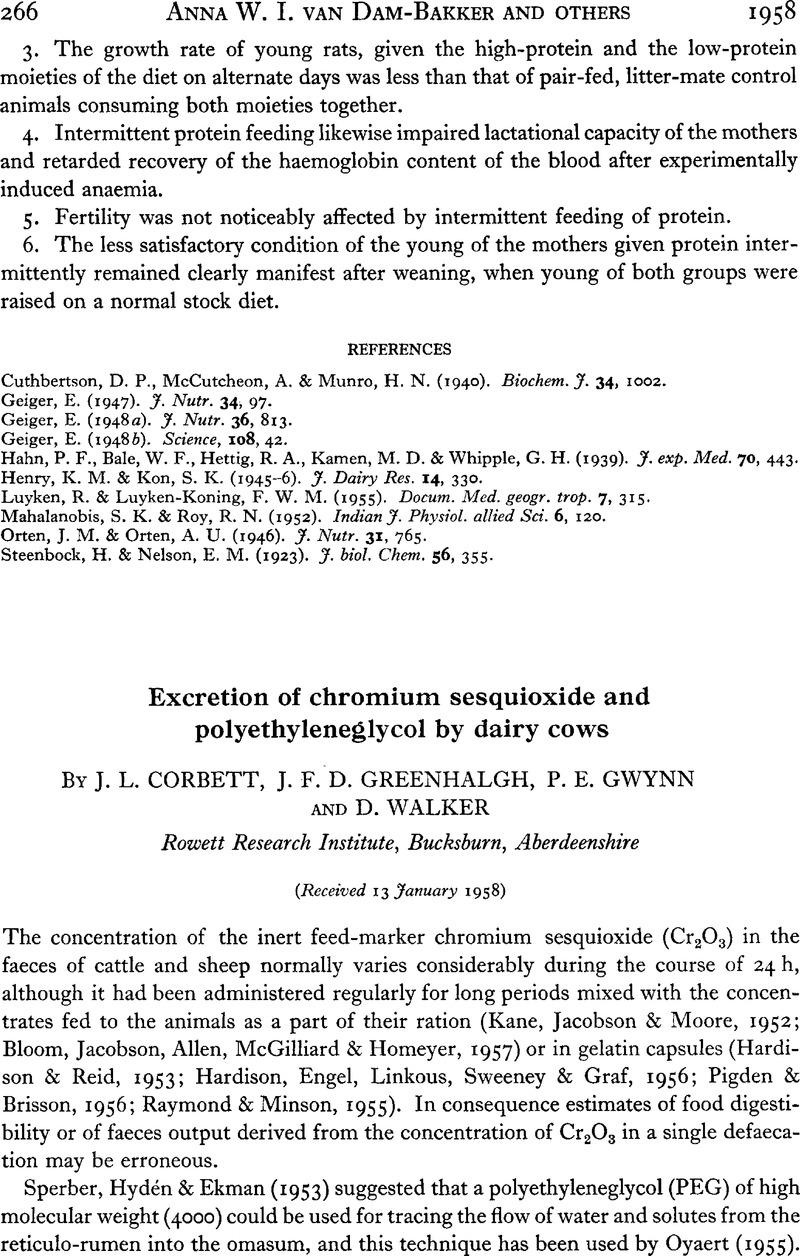Crossref Citations
This article has been cited by the following publications. This list is generated based on data provided by Crossref.
CORBETT, J. L.
GREENHALGH, J. F. D.
and
MACDONALD, A. P.
1958.
Paper as a Carrier of Chromium Sesquioxide.
Nature,
Vol. 182,
Issue. 4641,
p.
1014.
Corbett, J. L.
Greenhalgh, J. F. D.
and
Florence, E.
1959.
Distribution of chromium sesquioxide and polyethyleneglycol in the reticulo-rumen of cattle.
British Journal of Nutrition,
Vol. 13,
Issue. 3,
p.
337.
Blackburn, T. H.
and
Hobson, P. N.
1960.
The degradation of protein in the rumen of the sheep and redistribution of the protein nitrogen after feeding.
British Journal of Nutrition,
Vol. 14,
Issue. 4,
p.
445.
1960.
Abstracts of Communications.
Proceedings of the Nutrition Society,
Vol. 19,
Issue. 2,
p.
xiii.
Corbett, J. L.
Greenhalgh, J. F. D.
McDonald, I.
and
Florence, E.
1960.
Excretion of chromium sesquioxide administered as a component of paper to sheep.
British Journal of Nutrition,
Vol. 14,
Issue. 3,
p.
289.
Piatkowski, B.
Steger, H.
and
Püschel, F.
1962.
Bestimmung sowie Ausscheidung von Chromoxyd bei im Stall gefütterten und weidenden Milchkühen.
Archiv für Tierernaehrung,
Vol. 12,
Issue. 3,
p.
137.
Petersen, P. J.
and
Spedding, D. J.
1963.
The excretion by sheep of75selenium incorporated into red clover (Trifolium pratenseL.): The chemical nature of the excreted selenium and its uptake by three plant species.
New Zealand Journal of Agricultural Research,
Vol. 6,
Issue. 1-2,
p.
13.
Jacobson, Eugene D.
Bondy, Donald C.
Broitman, Selwyn A.
and
Fordtran, John S.
1963.
Validity of Polyethylene Glycol in Estimating Intestinal Water Volume.
Gastroenterology,
Vol. 44,
Issue. 6,
p.
761.
Ulyatt, M. J.
1964.
The use of polyethylene glycol as a marker for measuring rumen water volume and the rate of flow of water from the rumen of grazing sheep.
New Zealand Journal of Agricultural Research,
Vol. 7,
Issue. 4,
p.
713.
Moody, J.P.
and
Williams, R.T.
1964.
The metabolism of 4-hydroxy-3-nitrophenylarsonic acid in hens.
Food and Cosmetics Toxicology,
Vol. 2,
Issue. ,
p.
707.
Downes, A. M.
and
McDonald, I. W.
1964.
The chromium-51 complex of ethylenediamine tetraacetic acid as a soluble rumen marker.
British Journal of Nutrition,
Vol. 18,
Issue. 1,
p.
153.
Till, A. R.
and
Downes, A. M.
1965.
The preparation of tritium-labelled polyethylene glycol and its use as a soluble rumen marker.
British Journal of Nutrition,
Vol. 19,
Issue. 1,
p.
435.
1966.
The Rumen and its Microbes.
p.
466.
Sassoon, H.F.
1966.
Labelled chromium sesquioxide as a marker for digesta: Preparation and quantitative determination in faeces.
The International Journal of Applied Radiation and Isotopes,
Vol. 17,
Issue. 6,
p.
329.
Pfeffer, E.
Bertzbach, J.
and
Lenkeit, W.
1966.
Untersuchungen über das Verhalten der mineralischen Mengenelemente im Verdauungskanal von Schafen bei Zufütterung von NaCl oder KCl.
Zeitschrift für Tierphysiologie Tierernährung und Futtermittelkunde,
Vol. 22,
Issue. 1-5,
p.
115.
Lawlor, M. J.
Giesecke, D.
and
Walser-KÄrst, Karin
1966.
Comparative studies on the digestive physiology of sheep fed on semi-purified or roughage-concentrate diets.
British Journal of Nutrition,
Vol. 20,
Issue. 2,
p.
373.
Curran, M. K.
Leaver, J. D.
and
Weston, E. W.
1967.
A note on the use of chromic oxide incorporated in a feed to estimate faecal output in ruminants.
Animal Science,
Vol. 9,
Issue. 4,
p.
561.
Malawer, Sidney J.
and
Powell, Don W.
1967.
An Improved Turbidimetric Analysis of Polyethylene Glycol Utilizing an Emulsifier.
Gastroenterology,
Vol. 53,
Issue. 2,
p.
250.
EKMAN, L.
1967.
Radioecological Concentration Processes.
p.
547.
French, Arthur B.
Brown, Isabel F.
Good, Christopher J.
and
McLeod, Graham M.
1968.
Comparison of phenol red and polyethyleneglycol as nonabsorbable markers for the study of intestinal absorption in humans.
The American Journal of Digestive Diseases,
Vol. 13,
Issue. 6,
p.
558.



